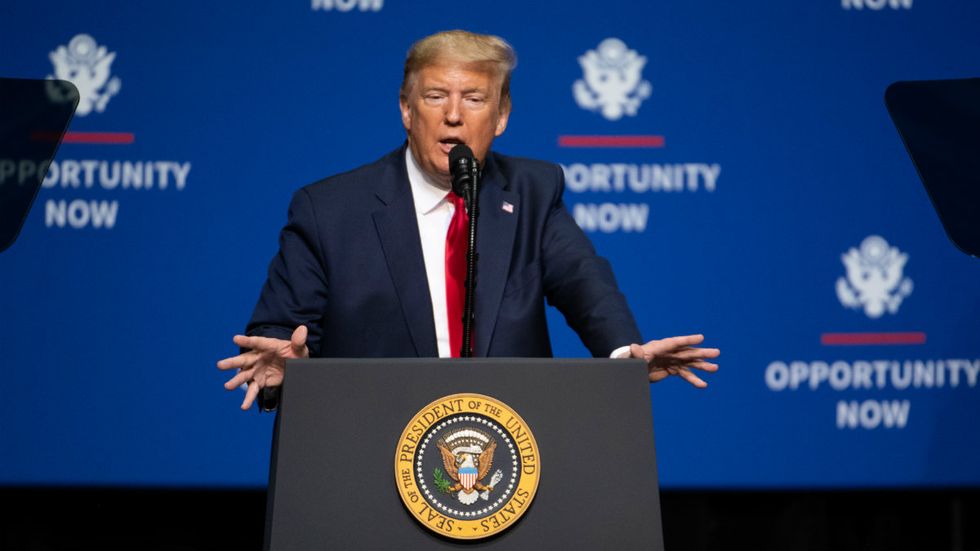
© 2025 Blaze Media LLC. All rights reserved.
Horowitz: Trump’s budget proposal shows he’s willing to cut spending if conservatives would fight for it
February 10, 2020
It’s become a perennial joke. Every year in February, Trump’s Office of Management and Budget (OMB) introduces an ambitious budget proposal to slash spending and abolish wasteful programs. Then, by the end of the year, not only is every principle of that proposal jettisoned in the actual budget signed by the president, but the new budget increases spending for every program that he promised to cut.
Yet the fact that the president is willing to put his name on a conservative budget demonstrates that it doesn’t have to be this way. If outside conservative organizations, media, and members of Congress would actually stay focused, President Trump’s second term can be more fiscally conservative.
The few of us who still care about limited government experienced heartburn when the president proposed more big government programs without mentioning the debt bomb during what was otherwise a terrific State of the Union Address last week. The president railed against socialism and how it “destroys nations,” then proceeded to propose ideas that can only be described as socialism lite.
The typical response I’ve heard from some colleagues is, “Well, Trump was never going to be a limited government president.” However, that is simply not true, as we see from his willingness to sign on to conservative budgets every year, more conservative than any president in modern history. Sure, the president was never going to make changes to Social Security and Medicare, but everything else – from Medicaid and welfare to foreign aid and domestic non-defense discretionary spending – was all fair game.
Unfortunately, unfocused conservatives have allowed Democrats to work with the ineffective GOP leaders in Congress to increase spending to record levels that blow out the shocking levels of the Obama era. Annual spending by the Department of Education, for example, is now up to $83 billion, 24 percent higher (in non-inflation-adjusted dollars) than during Obama’s spendathon in 2009. With a booming job market and record revenue, spending and deficits are blowing out the levels accrued during the deepest recession in generations.
But again, today’s budget release demonstrates that it doesn’t have to be this way. Trump will sign a bad budget if the swamp consensus coalesces around it. But at the same time, if conservatives work to back the non-swamp elements of the administration pushing for spending cuts the president is clearly OK with, he would sign a good budget as well.
In light of the recent increase in spending on foreign aid, the budget proposal cuts 21 percent from the State Department and international assistance programs. The EPA would be cut by 27 percent and energy subsidies by 29 percent. Overall, the budget envisions $2.4 trillion in 10-year cuts to discretionary spending and war spending from the baseline forecast and another $2 trillion in reductions from “mandatory spending” programs, such as food stamps and Medicaid.
The budget does, of course, include some big government proposals, such as a new “paid family leave” entitlement. However, it also contains a lot of spending cuts. But if conservatives don’t stay focused, we will be left with the bad stuff and none of the spending cuts, as has been the case for the first term.
The proposal also contains a critical funding increase for ICE. With over three million known criminal aliens targeted for deportation who remain in the country, ICE has just 5,000 deportation officers to deal with them. This proposal would increase ICE funding by $1.8 billion, which includes more funding for detention space as well as extra funding to hire several thousand more officers.
If nothing else, this budget demonstrates that the more we keep digging into the red, the further to the left the baseline on spending moves and the harder it will be to dig out. Even this budget, which the media will decry as draconian and heartless to the children, elderly, sick, and puppies, envisions $4.8 trillion in spending this year, which is higher than Obama’s final budget for fiscal year 2017, even adjusted for inflation. The total spending over 10 years is projected at $56.3 trillion. Of the $4.6 trillion in projected deficit reductions under the bill, roughly $1.5 billion is achieved through new revenue projections based on GDP growth we have failed to achieve, precisely because of the growth of the deficit. Time is of the essence.
If Trump weren’t open to conservative ideas in many areas of fiscal policy, he would not have Russ Vought as his budget guru. Clearly, his instincts are to cut at least some spending. The question is whether conservatives will take yes for an answer.
Want to leave a tip?
We answer to you. Help keep our content free of advertisers and big tech censorship by leaving a tip today.
Want to join the conversation?
Already a subscriber?
Blaze Podcast Host
Daniel Horowitz is the host of “Conservative Review with Daniel Horowitz” and a senior editor for Blaze News.
RMConservative
Daniel Horowitz
Blaze Podcast Host
Daniel Horowitz is the host of “Conservative Review with Daniel Horowitz” and a senior editor for Blaze News.
@RMConservative →more stories
Sign up for the Blaze newsletter
By signing up, you agree to our Privacy Policy and Terms of Use, and agree to receive content that may sometimes include advertisements. You may opt out at any time.
© 2025 Blaze Media LLC. All rights reserved.
Get the stories that matter most delivered directly to your inbox.
By signing up, you agree to our Privacy Policy and Terms of Use, and agree to receive content that may sometimes include advertisements. You may opt out at any time.



